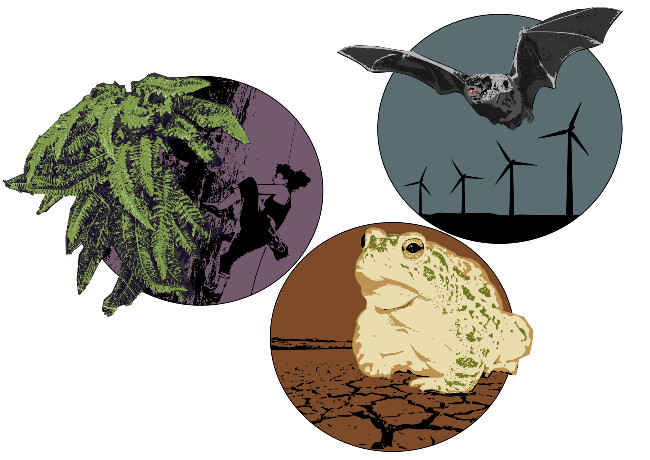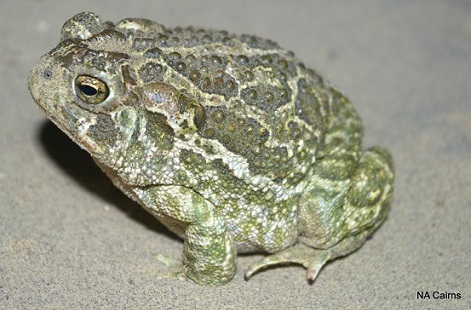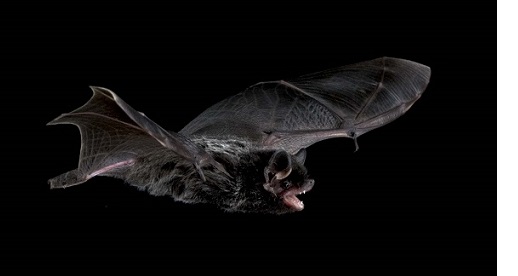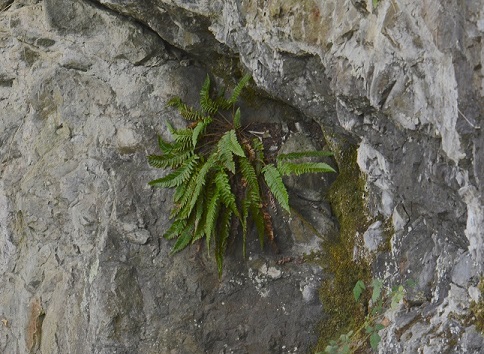Printable version (PDF - 587 kB)

Three species were assessed by COSEWIC at the May 2023 meeting that go unseen by most Canadians. California Sword Fern (purple circle) is found on hard-to-reach cliffs attractive for quarrying and rock climbing. Local conservation efforts are aiding in the preservation of the fern. Great Plains Toad (Opik watetew, orange circle) faces an uncertain future due to climate change, making the adoption of renewable energy sources crucial. Silver-haired Bat (blue circle) populations have declined significantly due to collisions with wind turbines, but simple mitigation steps are possible. Image credit: Caitlin Willier
(Regina, May 10, 2023) Many Canadian plants and animals often go unnoticed, yet healthy landscapes across the country depend on these near-invisible wonders of nature. COSEWIC, the Committee on the Status of Endangered Wildlife in Canada, met last week to consider the status of 16 wildlife species. These included several that go unseen – those that are active in the night or that live underground or in hard-to-reach places. Assessing secretive species underscores the importance of looking a little closer and learning all that we can to help them survive.

The committee considered the status of Great Plains Toad, found in the prairie potholes near the meeting in Regina – the homelands of the nêhiyawak, Anihšināpēk, Dakota, Lakota, Nakoda, and the Métis/Michif Nation.
According to Barbara Frazer, Plains Cree Knowledge Holder and Aboriginal Traditional Knowledge subcommittee (ATK) member, “Cree is verb based, this species is known as Opik watetew (large frog) descriptive in how it spends most of its time underground, below the frost. It belongs to the ayikis (frog) - Earth dweller family and its distinctive call announces the time of transition from winter into spring.”
This hermit is threatened by climate change because it needs seasonal pools of water for breeding, and these are becoming increasingly rare on the Prairies because of drought. The committee assessed the species as Special Concern.
Because they fly at night and don’t roost in large groups, Eastern Red, Hoary, and Silver-haired bats are elusive. These bats have faced losses in both habitat and food, as their roosting trees have been logged and their insect prey reduced by pesticides. And collisions with wind turbines on the bats’ migratory flight south in the autumn pose a substantial threat – hundreds of thousands of bats are estimated to be killed this way every year. The good news is that mitigation can allow renewable energy and bats to coexist on the landscape.

"Mitigation works. Turning wind turbines off for very short periods at low wind speeds during the fall season can reduce mortality by 50-80%, while minimally compromising energy generation,” notes Stephen Petersen, co-chair of COSEWIC’s terrestrial mammals subcommittee.
All three bat species have declined dramatically in recent years and the committee assessed each of them as Endangered.
In Canada, the California Sword Fern is found on limestone cliffs at only three sites in southern British Columbia, areas that are also desirable for quarry operations and rock climbing. The good news is that despite the value of limestone, the mine owner at one site has been participating in local plans to establish a park reserve to protect habitat. Another site is being protected from quarrying in favour of rock climbing. This means rock climbers can be key caretakers of these vulnerable ferns. The fern was assessed as Endangered.

Several of the assessed species are not just hard to see but have actually gone unseen for decades. Eastern Tiger Salamander, Northwestern Pond Turtle, Pacific Gophersnake, and Timber Rattlesnake were all re-assessed as Extirpated in Canada.
“Conservation is complicated,” said David Lee, chair of the committee, “but the more Canadians know about our hidden gems, the better our chances of preserving them.”
Next meeting
COSEWIC’s next scheduled wildlife species assessment meeting will be held in November 2023.
About COSEWIC
COSEWIC assesses the status of wild species, subspecies, varieties, or other important units of biological diversity, considered to be at risk in Canada. To do so, COSEWIC uses scientific, Aboriginal traditional and community knowledge provided by experts from governments, academia and other organizations. Summaries of assessments are currently available to the public on the COSEWIC website and will be submitted to the Federal Minister of the Environment and Climate Change in fall 2023 for listing consideration under the Species at Risk Act (SARA). At that time, the status reports and status appraisal summaries will be publicly available on the Species at Risk Public Registry.
At its most recent meeting, COSEWIC assessed 16 wildlife species in various COSEWIC risk categories, including 8 Endangered, 3 Special Concern, and 4 Extirpated (i.e. no longer found in the wild in Canada). In addition to these wildlife species that are in COSEWIC risk categories, COSEWIC assessed 1 as Data Deficient.
COSEWIC comprises members from each provincial and territorial government wildlife agency, four federal entities (Canadian Wildlife Service, Parks Canada Agency, Fisheries and Oceans Canada, and the Canadian Museum of Nature), four Non-government Science Members, Co-chairs of the Species Specialist and the Aboriginal Traditional Knowledge Subcommittees, and two early career scientists.
Definition of COSEWIC terms and status categories:
Wildlife Species: A species, subspecies, variety, or geographically or genetically distinct population of animal, plant or other organism, other than a bacterium or virus, that is wild by nature and is either native to Canada or has extended its range into Canada without human intervention and has been present in Canada for at least 50 years.
Extinct (X): A wildlife species that no longer exists.
Extirpated (XT): A wildlife species that no longer exists in the wild in Canada, but exists elsewhere.
Endangered (E): A wildlife species facing imminent extirpation or extinction.
Threatened (T): A wildlife species that is likely to become Endangered if nothing is done to reverse the factors leading to its extirpation or extinction.
Special Concern (SC): A wildlife species that may become Threatened or Endangered because of a combination of biological characteristics and identified threats.
Not at Risk (NAR): A wildlife species that has been evaluated and found to be not at risk of extinction given the current circumstances.
Data Deficient (DD): A category that applies when the available information is insufficient (a) to resolve a wildlife species’ eligibility for assessment or (b) to permit an assessment of the wildlife species’ risk of extinction.
Species at Risk: A wildlife species that has been assessed as Extirpated, Endangered, Threatened or Special Concern.
| Dr. David Lee Chair, COSEWIC Telephone: 514-366-9574 |
For general inquiries: COSEWIC Secretariat Canadian Wildlife Service Environment and Climate Change Canada 351 St. Joseph Blvd, 16th floor Gatineau QC K1A 0H3 www.cosewic.ca |
| For inquiries on amphibians and reptiles (Eastern Tiger Salamander (Carolinian population), Great Plains Toad, Northwestern Pond Turtle, Pacific Gophersnake, Timber Rattlesnake): Dr. Tom Herman Professor Emeritus Acadia University Telephone: 902-670-3535 |
For inquiries on arthropods (Riverine Clubtail): Jennifer M. Heron Telephone: 604-812-8198 |
| For inquiries on birds (Horned Grebe, Northern Bobwhite, Roseate Tern, Savannah Sparrow princeps subspecies, White-headed Woodpecker): Dr. Richard Elliot Scientist Emeritus Environment and Climate Change Canada Telephone: 506-229-9444 |
For inquiries on terrestrial mammals (Eastern Red Bat, Hoary Bat, Silver-haired Bat): Dr. Stephen D. Petersen Director, Conservation and Research Assiniboine Park Zoo Telephone: 204-793-4363 |
| For inquiries on vascular plants (California Sword Fern, Gulf of St. Lawrence Aster, Provancher's Fleabane): Del Meidinger Meidinger Ecological Consultants Ltd. Telephone (1): 250-881-1180 Telephone (2): 778-977-1180 |
For inquiries on Aboriginal Traditional Knowledge: Roger Gallant Telephone: 709-638-4343 |

